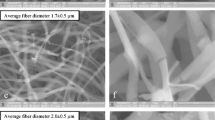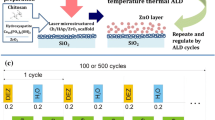Abstract
Nitrogen-doped thin titanium dioxide films formed by the reactive magnetron sputtering method on the surface of PLLA electrospun microfibers scaffold were investigated. It was shown that the chemical composition of the films is shifting from titanium dioxide (TiO2) composites saturated with C–NH, C=N, N–C=N and HN–C=O compounds to solid solutions of titanium oxides (TixOy) and titanium oxynitrides (TiOxNy) with the increased time of the treatment. An empirical model describing changes in the chemical composition of the surface due to the treatment was proposed. It was shown that the modification of the PLLA microfibers scaffolds surface improves cell-scaffold and cell–cell interactions with the highest number of viable adherent cells observed on the scaffold treated for 4 min.





Similar content being viewed by others
References
Hamad K, Kaseem M, Yang HW et al (2015) Properties and medical applications of polylactic acid: a review. Express Polym Lett 9:435–455. https://doi.org/10.3144/expresspolymlett.2015.42
Tian H, Tang Z, Zhuang X et al (2012) Biodegradable synthetic polymers: preparation, functionalization and biomedical application. Prog Polym Sci 37:237–280. https://doi.org/10.1016/j.progpolymsci.2011.06.004
Teo WE, Ramakrishna S (2006) A review on electrospinning design and nanofibre assemblies. Nanotechnology 17:R89–R106. https://doi.org/10.1088/0957-4484/17/14/R01
Bhardwaj N, Kundu SC (2010) Electrospinning: a fascinating fiber fabrication technique. Biotechnol Adv 28:325–347. https://doi.org/10.1016/j.biotechadv.2010.01.004
Santoro M, Shah SR, Walker JL, Mikos AG (2016) Poly(lactic acid) nanofibrous scaffolds for tissue engineering. Adv Drug Deliv Rev 107:206–212. https://doi.org/10.1016/j.addr.2016.04.019
Jiang T, Carbone EJ, Lo KW-H, Laurencin CT (2014) Electrospinning of Polymer Nanofibers for Tissue Regeneration. Prog Polym Sci 46:1–24. https://doi.org/10.1016/j.progpolymsci.2014.12.001
von der Mark K, Park J (2013) Engineering biocompatible implant surfaces. Prog Mater Sci 58:327–381. https://doi.org/10.1016/j.pmatsci.2012.09.002
Bacakova L, Filova E, Parizek M et al (2011) Modulation of cell adhesion, proliferation and differentiation on materials designed for body implants. Biotechnol Adv 29:739–767. https://doi.org/10.1016/j.biotechadv.2011.06.004
Demina TS, Gilman AB, Zelenetskii AN (2017) Application of high-energy chemistry methods to the modification of the structure and properties of polylactide (a review). High Energy Chem 51:302–314. https://doi.org/10.1134/S0018143917040038
Moussa M, Fontana P, Hamdan F et al (2016) Modulation of osteoblast behavior on TiN x O y coatings by altering the N/O stoichiometry while maintaining a high thrombogenic potential. J Biomater Appl 30:1219–1229. https://doi.org/10.1177/0885328215619084
Durual S, Pernet F, Rieder P et al (2011) Titanium nitride oxide coating on rough titanium stimulates the proliferation of human primary osteoblasts. Clin Oral Implants Res 22:552–559. https://doi.org/10.1111/j.1600-0501.2010.02033.x
Moussa M, Banakh O, Wehrle-Haller B et al (2017) TiN x O y coatings facilitate the initial adhesion of osteoblasts to create a suitable environment for their proliferation and the recruitment of endothelial cells. Biomed Mater 12:025001. https://doi.org/10.1088/1748-605X/aa57a7
Karjalainen PP, Ylitalo A, Airaksinen JK, Nammas W (2010) Titanium-nitride-oxide-coated Titan-2 bioactive coronary stent: a new horizon for coronary intervention. Expert Rev Med Devices 7:599–604. https://doi.org/10.1586/erd.10.44
Cyster LA, Parker KG, Parker TL, Grant DM (2003) The effect of surface chemistry and nanotopography of titanium nitride (TiN) films on 3T3-L1 fibroblasts. J Biomed Mater Res 67A:138–147. https://doi.org/10.1002/jbm.a.10087
Windecker S, Mayer I, De Pasquale G et al (2001) Stent coating with titanium-nitride-oxide for reduction of neointimal hyperplasia. Circulation 104:928–933
Mosseri M, Miller H, Tamari I et al (2006) The Titanium-NO Stent:results of a multicenter registry. EuroIntervention 2:192–196
Sukhorukova IV, Sheveyko AN, Firestein KL et al (2017) Mechanical properties of decellularized extracellular matrix coated with TiCaPCON film. Biomed Mater 12:035014. https://doi.org/10.1088/1748-605X/aa6fc0
Bolbasov EN, Antonova LV, Stankevich KS et al (2017) The use of magnetron sputtering for the deposition of thin titanium coatings on the surface of bioresorbable electrospun fibrous scaffolds for vascular tissue engineering: a pilot study. Appl Surf Sci 398:63–72. https://doi.org/10.1016/j.apsusc.2016.12.033
Slepička P, Malá Z, Rimpelová S, Švorčík V (2016) Antibacterial properties of modified biodegradable PHB non-woven fabric. Mater Sci Eng C 65:364–368. https://doi.org/10.1016/j.msec.2016.04.052
Arnell R, Kelly P (1999) Recent advances in magnetron sputtering. Surf Coat Technol 112:170–176. https://doi.org/10.1016/S0257-8972(98)00749-X
Bolbasov EN, Maryin PV, Stankevich KS et al (2018) Surface modification of electrospun poly-(l -lactic) acid scaffolds by reactive magnetron sputtering. Colloids Surfaces B Biointerfaces 162:43–51. https://doi.org/10.1016/j.colsurfb.2017.11.028
Bochevarov AD, Harder E, Hughes TF et al (2013) Jaguar: a high-performance quantum chemistry software program with strengths in life and materials sciences. Int J Quantum Chem 113:2110–2142. https://doi.org/10.1002/qua.24481
Baudin B, Bruneel A, Bosselut N, Vaubourdolle M (2007) A protocol for isolation and culture of human umbilical vein endothelial cells. Nat Protoc 2:481–485. https://doi.org/10.1038/nprot.2007.54
Dolci LS, Quiroga SD, Gherardi M et al (2014) Carboxyl surface functionalization of poly(l-lactic acid) Electrospun Nanofibers through Atmospheric Non-Thermal Plasma Affects Fibroblast Morphology. Plasma Process Polym 11:203–213. https://doi.org/10.1002/ppap.201300104
Neuhäuser M, Bärwulf S, Hilgers H et al (1999) Optical emission spectroscopy studies of titanium nitride sputtering on thermoplastic polymers. Surf Coatings Technol 116–119:981–985. https://doi.org/10.1016/S0257-8972(99)00214-5
Boumerzoug M, Pang Z, Boudreau M et al (1995) Room temperature electron cyclotron resonance chemical vapor deposition of high quality TiN. Appl Phys Lett 66:302–304. https://doi.org/10.1063/1.113525
Vandevelde T, Nesladek M, Quaeyhaegens C, Stals L (1996) Optical emission spectroscopy of the plasma during CVD diamond growth with nitrogen addition. Thin Solid Films 290–291:143–147. https://doi.org/10.1016/S0040-6090(96)09189-4
Dunn TM, Hanson LK, Rubinson KA (1970) Rotational analysis of the red electronic emission system of titanium nitride. Can J Phys 48:1657–1663. https://doi.org/10.1139/p70-209
Mahieu S, Depla D (2009) Reactive sputter deposition of TiN layers: modelling the growth by characterization of particle fluxes towards the substrate. J Phys D Appl Phys 42:053002. https://doi.org/10.1088/0022-3727/42/5/053002
Pham QP, Sharma U, Mikos AG (2006) Electrospun poly(ε-caprolactone) microfiber and multilayer nanofiber/microfiber scaffolds: characterization of scaffolds and measurement of cellular infiltration. Biomacromol 7:2796–2805. https://doi.org/10.1021/bm060680j
Shim IK, Jung MR, Kim KH et al (2010) Novel three-dimensional scaffolds of poly(L-lactic acid) microfibers using electrospinning and mechanical expansion: fabrication and bone regeneration. J Biomed Mater Res Part B Appl Biomater 95B:150–160. https://doi.org/10.1002/jbm.b.31695
Fioretta ES, Simonet M, Smits AIPM et al (2014) Differential response of endothelial and endothelial colony forming cells on electrospun scaffolds with distinct microfiber diameters. Biomacromol 15:821–829. https://doi.org/10.1021/bm4016418
Zhu X, Cui W, Li X, Jin Y (2008) Electrospun fibrous mats with high porosity as potential scaffolds for skin tissue engineering. Biomacromol 9:1795–1801. https://doi.org/10.1021/bm800476u
Wang Z, Cui Y, Wang J et al (2014) The effect of thick fibers and large pores of electrospun poly(ε-caprolactone) vascular grafts on macrophage polarization and arterial regeneration. Biomaterials 35:5700–5710. https://doi.org/10.1016/j.biomaterials.2014.03.078
Kot M, Łobaza J, Naumann F et al (2018) Long-term ambient surface oxidation of titanium oxynitride films prepared by plasma-enhanced atomic layer deposition: an XPS study. J Vac Sci Technol Vacu Surfaces Film 36:01A114. https://doi.org/10.1116/1.5003356
Grosso S, Latu-Romain L, Berthomé G et al (2017) Titanium and titanium nitride thin films grown by dc reactive magnetron sputtering Physical Vapor Deposition in a continuous mode on stainless steel wires: chemical, morphological and structural investigations. Surf Coat Technol 324:318–327. https://doi.org/10.1016/j.surfcoat.2017.05.089
Ferreira BMP, Pinheiro LMP, Nascente PAP et al (2009) Plasma surface treatments of poly(l-lactic acid) (PLLA) and poly(hydroxybutyrate-co-hydroxyvalerate) (PHBV). Mater Sci Eng C 29:806–813. https://doi.org/10.1016/j.msec.2008.07.026
Renò F, D’Angelo D, Gottardi G et al (2012) Atmospheric pressure plasma surface modification of poly(d, l-lactic acid) increases fibroblast, osteoblast and keratinocyte adhesion and proliferation. Plasma Process Polym 9:491–502. https://doi.org/10.1002/ppap.201100139
Sarapirom S, Yu LD, Boonyawan D, Chaiwong C (2014) Effect of surface modification of poly (lactic acid) by low-pressure ammonia plasma on adsorption of human serum albumin. Appl Surf Sci 310:42–50
Jeyachandran YL, Narayandass SK, Mangalaraj D et al (2007) Properties of titanium nitride films prepared by direct current magnetron sputtering. Mater Sci Eng A 445–446:223–236. https://doi.org/10.1016/j.msea.2006.09.021
Demina T, Zaytseva-Zotova D, Yablokov M et al (2012) DC discharge plasma modification of chitosan/gelatin/PLLA films: surface properties, chemical structure and cell affinity. Surf Coat Technol 207:508–516. https://doi.org/10.1016/j.surfcoat.2012.07.059
Pustovalova AA, Pichugin VF, Ivanova NM, Bruns M (2017) Structural features of N-containing titanium dioxide thin films deposited by magnetron sputtering. Thin Solid Films 627:9–16. https://doi.org/10.1016/j.tsf.2017.02.056
Kuznetsov MV, Zhuravlev JF, Gubanov VA (1992) XPS analysis of adsorption of oxygen molecules on the surface of Ti and TiNx films in vacuum. J Electron Spectros Relat Phenomena 58:169–176. https://doi.org/10.1016/0368-2048(92)80016-2
Kersten H, Deutsch H, Steffen H et al (2001) The energy balance at substrate surfaces during plasma processing. Vacuum 63:385–431. https://doi.org/10.1016/S0042-207X(01)00350-5
Petrov I, Myers A, Greene JE, Abelson JR (1994) Mass and energy resolved detection of ions and neutral sputtered species incident at the substrate during reactive magnetron sputtering of Ti in mixed Ar + N 2 mixtures. J Vac Sci Technol Vac Surfaces Film 12:2846–2854. https://doi.org/10.1116/1.578955
Morent R, De Geyter N, Trentesaux M et al (2010) Influence of discharge atmosphere on the ageing behaviour of plasma-treated polylactic acid. Plasma Chem Plasma Process 30:525–536. https://doi.org/10.1007/s11090-010-9233-8
Inagaki N, Narushima K, Tsutsui Y, Ohyama Y (2002) Surface modification and degradation of poly(lactic acid) films by Ar-plasma. J Adhes Sci Technol 16:1041–1054. https://doi.org/10.1163/156856102760146156
Homma Y, Chiashi S, Yamamoto T et al (2013) Photoluminescence measurements and molecular dynamics simulations of water adsorption on the hydrophobic surface of a carbon nanotube in water vapor. Phys Rev Lett 110:157402. https://doi.org/10.1103/PhysRevLett.110.157402
Cao P, Xu K, Varghese JO, Heath JR (2011) The microscopic structure of adsorbed water on hydrophobic surfaces under ambient conditions. Nano Lett 11:5581–5586. https://doi.org/10.1021/nl2036639
Chen VJ, Smith LA, Ma PX (2006) Bone regeneration on computer-designed nano-fibrous scaffolds. Biomaterials 27:3973–3979. https://doi.org/10.1016/j.biomaterials.2006.02.043
Gibson PW, Schreuder-Gibson HL, Rivin D (1999) Electrospun fiber mats: transport properties. AIChE J 45:190–195. https://doi.org/10.1002/aic.690450116
Fletcher AJ, Yüzak Y, Thomas KM (2006) Adsorption and desorption kinetics for hydrophilic and hydrophobic vapors on activated carbon. Carbon N Y 44:989–1004. https://doi.org/10.1016/j.carbon.2005.10.020
Slepička P, Malá Z, Rimpelová S et al (2015) Plasma treatment of the surface of poly(hydroxybutyrate) foil and non-woven fabric and assessment of the biological properties. React Funct Polym 95:71–79. https://doi.org/10.1016/j.reactfunctpolym.2015.08.010
Riester M, Bärwulf S, Lugscheider E, Hilgers H (1999) Morphology of sputtered titanium nitride thin films on thermoplastic polymers. Surf Coat Technol 116–119:1001–1005
Balducci G, Gigli G, Guido M (1985) Identification and stability determinations for the gaseous titanium oxide molecules Ti2O3 and Ti2O4. J Chem Phys 83:1913–1916. https://doi.org/10.1063/1.449378
Shehzad N, Tahir M, Johari K et al (2018) A critical review on TiO2 based photocatalytic CO2 reduction system: strategies to improve efficiency. J CO2 Util 26:98–122. https://doi.org/10.1016/j.jcou.2018.04.026
Acknowledgements
This research was supported by Tomsk Polytechnic University Competitiveness Enhancement Program project VIU-SEC B.P. Veinberg-210/2018. The authors acknowledge the Resource Center of Saint-Petersburg State University “Physical methods of surface investigation” for conducting XPS study.
Author information
Authors and Affiliations
Corresponding author
Additional information
Publisher's Note
Springer Nature remains neutral with regard to jurisdictional claims in published maps and institutional affiliations.
Rights and permissions
About this article
Cite this article
Bolbasov, E.N., Maryin, P.V., Stankevich, K.S. et al. Nitrogen-Doped Titanium Dioxide Thin Films Formation on the Surface of PLLA Electrospun Microfibers Scaffold by Reactive Magnetron Sputtering Method. Plasma Chem Plasma Process 39, 503–517 (2019). https://doi.org/10.1007/s11090-019-09956-x
Published:
Issue Date:
DOI: https://doi.org/10.1007/s11090-019-09956-x




